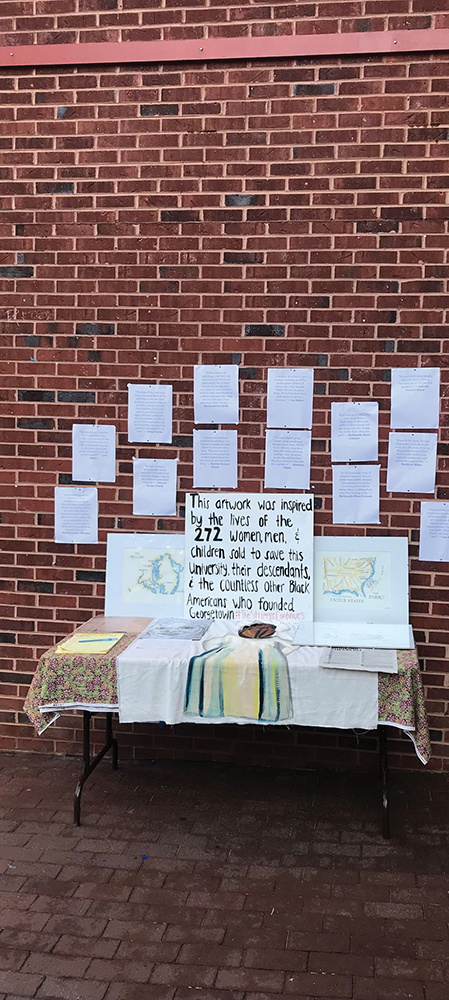
An Art exhibit celebrating the lives of the GU 272 went on display Tuesday morning. Mélisande Short-Colomb, one of the principal organizers, said she hopes this raises awareness in the Georgetown community about the university’s history with slavery and prevents current dialogue from dying out.
Student-made artwork honoring the lives of the 272 slaves sold by Georgetown in 1838 were hung in Red Square on Tuesday morning. The art installation, which, weather permitting, will be taken down on Friday, was created as part of the GU272 campaign that began in 2015.
Mélisande Short-Colomb (COL ’21), a descendant of one of the 272 slaves sold, helped organize the installation. Short-Colomb said that the installation was aimed at sparking conversation about the GU272 slaves and continuing to educate new and returning students about the GU272.
“If the university doesn’t actively include the history of the university, the GU272, their slaveholding, human trafficking practices, incoming generations of students will not know,” she said. “The students that were involved in the action in 2015, many of them have already graduated or they are moving out.”
The display includes maps created by Amalia Stahl (COL ‘21), portraits by Maya Archer (SFS ’21) and Eliza Phillips (COL ’21) and an abstract piece painted by Tristan MacHale (COL ’19).
Stahl said that she hopes that her piece educates community members who have limited knowledge about the GU272 slaves.
Maya Archer (SFS ’21) painted a faceless portrait for the installation as a focus on the men, women and children involved in the trade. Archer was frustrated by the lack of student activism and information surrounding the 1838 sale.
“It made me … frustrated that a I could only find three pictures of this whole legacy we have at this school, and that something as small as an art show is the biggest thing we’ve done in the past two years besides a small little book that’s been brought out by a couple faculty and a couple students,” Archer said.
MacHale said that his abstract piece was meant to highlight the lack of publicity that the university gave to the 1838 sale prior to the GU272 campaign.
“The main idea was to have something blurred in the background coming into focus in the foreground, like Georgetown — I don’t know if it was intentional, but they just like let it be hid under the rug,” MacHale said. “I’m not sure who found it, but some people found the documents and just started like digging in and like bringing it to focus,” MacHale said.
Phillips made Short-Colomb the subject of her portrait and included quotes from Short-Colomb to draw attention to the experience of the descendants and their voices. Phillips said that she hoped her piece would remind members of the community to listen to the descendants when discussing the sale and the reparations to make.
“The main message I want to send to the Georgetown community, and especially the university itself, is how when they’re trying to, when they’re having conversations about reparations and reparative action that they should make sure the descendants remain heavily involved in these conversations,” Phillips said.
Phillips is a member of The Hoya and traveled to Maringouin, La. in June on The Hoya’s reporting trip to learn about the descendants of the GU272.
The artists and Short-Colomb spoke of the necessity of campaigns such as the art installation to increase awareness and conversation about the GU272 campaign and Georgetown’s history with slavery. Archer said that she hoped that this campaign sparks dialogue about Georgetown’s history.
“I just hope it starts a conversation at least because it’s something that we like gloss over,” Archer said. “We talked about it like I said last year, and maybe this would have influenced my decision of coming to Georgetown if I had actually thought about this more.”
Stahl said she thought that if the broader Georgetown community is made aware of the history surrounding the GU272, students would be able to have a greater influence on how the community addresses it.
“It’s a part of Georgetown’s identity, for better or for worse,” Stahl said. “And I think it’s very important that it’s coming to light now, even though it’s very late, and I think that more students should be aware of what happened and that might shift just the way we treat people in general and the whole idea of reparations or no reparations.”
Events like the art installation are crucial to spreading awareness and understanding about the university’s past, Short-Colomb said.
“Everybody worked really hard to get here and you hear all the time around the campus, you get these high fives and these praises for doing a job really well. You got here, you made it. There’s so many people who never got that high five,” Short-Colomb said. “Two hundred and seventy-two people who were disposable to the people who say they care about you. So, I think I would like to send a message to all young people entering this school, any school, to dig a little bit deeper. Don’t trust everything you hear.”
Correction: A previous version of this article incorrectly referred to Tristan MacHale as Travis MacHale




















